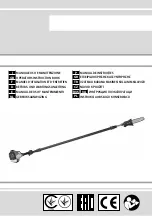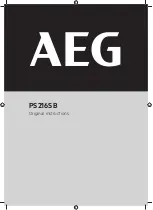
11
6. Turn single hex adjustment screw (P
1
) so blade
starts to move away from wheel shoulder. Then
immediately turn single hex adjustment screw in
opposite direction so that blade stops, then
moves slowly toward shoulder.
Keep fingers clear of blade
and wheel to avoid injury.
7. Turn single hex adjustment screw (P
1
) to stop
motion of blade on wheel as it gets closer to
wheel shoulder. Put a 6-inch length of paper
between blade and wheel. The paper should
not be cut as it passes between wheel shoulder
and blade.
8. Turn single hex adjustment screw (P
1
) a small
amount. Repeat insertion of paper between
wheel shoulder and blade until paper is cut in
two pieces.
NOTE:
You may have to repeat the
check with the paper several times before blade
and shoulder cuts paper into two pieces. Do not
hurry this adjustment; patience and accuracy
here will pay off with better, more accurate,
quieter cutting and much longer machine and
blade life.
9. When the paper is cut, turn hex adjustment
screw (P
1
) slightly counterclockwise. This
assures that blade is not rubbing excessively
against wheel shoulder.
10. Shut off saw.
11. Hold hex adjustment screws (P, P
1
) with a
wrench and tighten center locking screws (O).
Make sure hex adjustment screws do not move
while tightening center screws.
12. Adjust left and right bearing guide assemblies.
See
sect. 7-3
.
13. Install left blade guard and close wheel cover.
7.5
Belt tension
Refer to Figure 7-5.
1. Disconnect machine from power source.
2. Open pulley cover (R, Figure 7-5).
3. Loosen knob (S) and lift handle upward (T) to
tension belt.
4. Retighten knob (S).
Figure 7-5: belt tensioning
7.6
Vise adjustment
Refer to Figures 7-6 and 7-7.
7.6.1
Vise positioning
The workpiece is placed between the vise jaws with
required amount to be cut-off extending past blade.
To position floating jaw (A, Figure 7-6), pull out stop
pin (B) and manually slide jaw into general position.
Reinstall stop pin in appropriate hole. Use switch on
control panel to move vise against workpiece.
The floating jaw can be positioned before or behind
blade to accommodate bow position when mitering.
Loosen both handles (C) and push assembly along
T-slot. Make sure floating jaw will clear blade and
bow components, then tighten
both
handles (C).
Figure 7-6: vise positioning












































